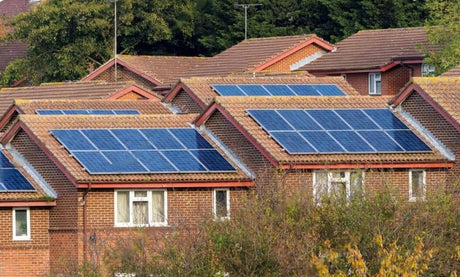Adding battery storage to your solar installation is more affordable than ever before.
The costs of solar battery storage used to be expensive and out of reach for most people. However, the cost of battery technology has significantly dropped as technology improves, so there’s never been a better time to add a battery bank to your solar power set-up.
When it comes time to choose a solar storage option, there are several solar battery choices. Renogy offers three kinds of solar deep-cycle batteries: gel, absorbent gel matt (AGM), and lithium-ion phosphate. Each battery comes with its own pros and cons, but in this article, we will look specifically at using lithium batteries in solar panel set-ups.
What Are Lithium Batteries?
A lithium-ion battery is a type of rechargeable solar battery. Lithium-ion or Li-ion batteries are commonly used batteries in solar power set-ups. They are good battery choices for powering portable electronics and electric vehicles.
Lithium-ion batteries are highly efficient, low-maintenance, and long-lasting battery storage solutions. They are compatible with a range of solar installations. You can add battery storage to an on-grid solar system to make it more powerful. Or, if you’re living off-grid, then solar batteries can give you additional flexibility, capacity, and peace of mind.
Benefits of lithium ion batteries over other batteries:
- Longer battery life
- Better thermal stability
- Greater safety features
- Compatible with many deep-cycle applications
- Light and compact
- More powerful than its other 100Ah counterparts
- Retains higher voltage than its 100Ah counterparts
- No toxic gasses
- Require little maintenance
- Can be safely be mounted in any position
Lithium-ion phosphate batteries are the top-of-the-line choice for solar storage applications and a great solar storage solution for anyone who is looking for an efficient battery with a long lifespan.
How long do lithium-ion batteries last?
Lithium-ion batteries have a long lifespan compared to many other battery types. The minimum lifespan of a lithium-ion battery is about three years or 300 to 500 charge cycles, whichever happens first. One charge cycle is considered a period of use from when the battery is fully charged to fully discharged, then fully recharged again.
However, most lithium-ion batteries will last much longer than the minimum, in the 10–15 year range. The lifespan of these batteries is up to three times longer than the five to seven-year lifespan of cheaper lead-acid batteries.
How much are lithium-ion solar batteries?
Depending on the manufacturer, features, and number of batteries you need, the price tag for lithium-ion batteries can reach around $9,000.
The many benefits lithium-ion solar batteries have do come with a higher price tag. These are the most expensive type of batteries in the Renogy range. Prices for our lithium-ion batteries start at $499 for the Lithium Iron Phosphate Battery 12 Volt 50 Ah and run up to $1,699.99 for the 48V 50Ah Smart Lithium Iron Phosphate Battery.
Although these batteries are more expensive, they are more cost-effective in the long term because they have a long cycle life and higher charge and discharge rates. The life cycle of these batteries is 3x as much as regular deep cycle batteries. The upfront investment pays off within just a few years.
What is the best battery to use for solar power?
Lithium-ion batteries are generally the best option for your solar panel system, although they are more expensive upfront.
Unlike a lead-acid battery, a lithium battery does not need a float charge. A lithium battery can be maintained with a full cycle (charged and discharged) just once every six to twelve months.
Lithium-ion batteries are typically a better bet if you’re looking to power equipment that requires a lot of electricity.
Which battery is better, NiMH or lithium-ion?
Both types of batteries are durable, but they do come with pros and cons.
Lithium-ion batteries are made of carbon and highly reactive lithium to store a lot of energy. Nickel metal hydride (NiMH) batteries use hydrogen to store energy and are made with nickel and another metal.
NiMH batteries are cheaper than lithium-ion batteries, but they are also larger and heavier. Other cons of NiMH batteries are their low voltage output, long charge times, and sensitivity to extreme temperatures. Li-ions have a much faster charge and can better withstand extremely low temperatures and warmer environments.
Long term storage
Lithium-ion batteries are some of the most straightforward solar batteries to store because they lose less capacity when idle than other battery types. The slow self-discharge rates are helpful when solar energy is only occasionally used, such as on a boat or a seasonal cabin.
You can easily store a lithium battery for a year; just ensure it has some charge, 50% – 60% ideally before you put it away. Storing the battery with some charge will give you a more extended period before self-discharge brings the voltage close to the danger point.
You can also store these batteries at low temperatures without issue in as low as -40 degrees celsius. High temperatures can be more of an issue in warmer countries. Luckily, that’s not a problem in Britain, as lithium batteries can be stored safely in temperatures up to 45 degrees celsius.
The average battery shelf life for lithium batteries is between two and four years. To improve your battery’s life, you should avoid storing batteries either completely full or empty. Additionally, if you’re storing batteries for periods longer than a few months, be sure to disconnect all wires from them.
Conclusion
Lithium batteries are a low maintenance option that pays off over time. They typically have a lifespan of at least ten years which means you get more usage from these batteries over other options. If you can afford to invest in a lithium iron phosphate battery upfront, it will pay off with benefits for years to come.
Resources
https://www.power-sonic.com/blog/how-to-charge-lithium-iron-phosphate-lifepo4-batteries/
https://battlebornbatteries.com/charging-lithium-batteries-the-basics/










